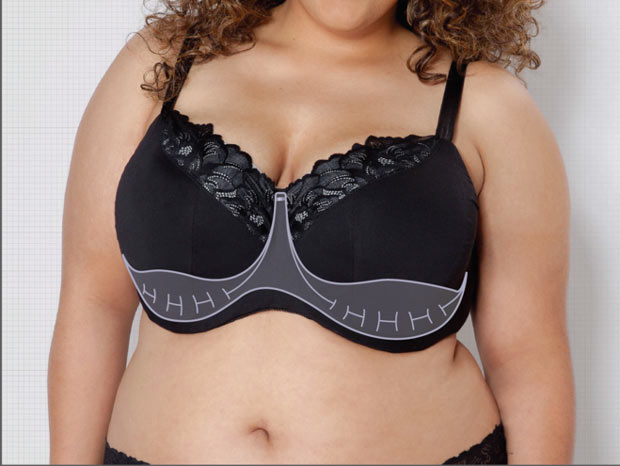Bra Startup Supports Women with SOLIDWORKS and ANSYS Software

Trusst Lingerie’s patent-pending design shifts support from the bra’s straps to underneath the bust. Image courtesy of Trusst Lingerie.
Latest News
February 22, 2016
It’s a staple in every woman’s wardrobe. And despite its necessity, women everywhere are always on the lookout for the perfect one to provide ultimate comfort with a little bit of style. The bra’s design has included a mix of wire and fabric for over a century, but that doesn’t mean it’s giving the necessary support for women of all cup sizes.
Trusst Lingerie is a group of women focused on creating a new type of bra that relies on a proprietary support system to provide better comfort for larger-busted women. In order to do so, the company has taken an engineering-based approach, relying on technology and software from SOLIDWORKS, ANSYS and MakerBot to manufacture its line of three bras: the Jessica, Suzanne and Marjory.
“Combining a lot of our shared experiences, we realized that there are so many aspects of wearing a bra that create a lot of pain points, most specifically for the larger busted woman, considering it’s something that she wears every day,” says Sophia Berman, CEO and co-founder of Trusst.
Shaking Up Design
Designing such a garment to fit a multitude of women is no easy task. “A lot of [the work] has been getting the right fit. There’s a lot of different body types, shapes and sizes, and women have lots of different preferences [for their bra]. So trying to hone down on exactly what the biggest pain points were and what we wanted to change the most [has been our focus],” says Berman.
The biggest change? Removing the underwire completely and taking inspiration from bridge design and architecture. The goal was to provide comfort and necessary support to the added mass, motion and force that comes with a bigger bust.
 Trusst Lingerie’s patent-pending design shifts support from the bra’s straps to underneath the bust. Image courtesy of Trusst Lingerie.
Trusst Lingerie’s patent-pending design shifts support from the bra’s straps to underneath the bust. Image courtesy of Trusst Lingerie.“The overall design that we chose really came about because the breast is a force and mass that comes off the chest, and the only way to really support it is from underneath,” Berman notes. However, Trusst’s design focuses on redistributing the weight over a larger surface area and removing most of the weight strain from the bra’s straps — similar to a bridge truss. Traditionally the underwire, which is a centralized point of contact, tends to act more as a frame for cup than an effective support system.
Materials are also an important consideration, since larger busts can mean more sweat and discomfort. Trusst’s offerings include antimicrobial and wicking fabrics to increase coolness and add airflow.
A Hybrid Approach
While hands-on testing was an integral component in helping Trusst figure out is main designs, CAD and CAE software also played a role in bringing the bras to production.
“We use a MakerBot [printer] and SOLIDWORKS models to do a lot of our rapid prototyping in-house,” says Laura West, CPO and co-founder. “We’ve [also] started using ANSYS to do some introductory FEA (finite element analysis) to study the motion of forces and potential failure points, and how that correlates to what comes from our manufacturer. When you have such a complex geometry paired with the materials we’ve chosen, 3D printing can only do so much.”
Software also helps streamline production variables. “In general, the structure is created using SOLIDWORKS, there were prototypes made and we refined that model so that it can be manufactured consistently,” West says. “Any structural details we put in SOLIDWORKS, [then would] print it, test it and modify it.”
Still, even software tools integrated throughout the workflow, the best way to figure out the design is through real feedback and extensive prototyping. Before settling on its main design, the team produced a couple hundred 3D-printed prototypes to test various cups, straps and widths.
“Well there’s so much variability in female bodies — there’s not any two [alike] even within the same cup size,” West notes. “We wanted to try and test on a range to really figure out what fits the majority of our customers.” West adds that the best way to account for this variation is to really test designs on an individual basis.
Kickstarting a New Standard
While testing and refining its designs, Trusst also turned to Kickstarter for additional support. In April 2015, the campaign was successfully funded, tripling its original goal of $25K. “We used Kickstarter as a market validation tool for styling and cut. All of our styles have sold pretty evenly across the board,” Berman says.
In December 2015, Trusst started production of its lingerie line for its Trusst-ees and is continuing to perfect its designs. The company’s combined workflow of traditional testing and engineering software is helping disrupt the way bras are being made.
Subscribe to our FREE magazine, FREE email newsletters or both!
Latest News
About the Author
Jess Lulka is a former associate editor for Digital Engineering. Contact her via [email protected].
Follow DE





